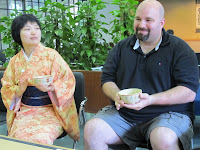Of the two places we stayed, the Three Sister’s Inn Annex captured what I had previously understood to be the quintessential Japanese living experience. The Weekly Mansion, while most likely representative of average Japanese business accommodations, lacked much (if not all) of the cultural influence seen in the later hotel. Rather, The Weekly Mansion felt almost ubiquitous while having been the first place we stayed in Japan. Aside from runny eggs, The Three Sister’s Inn Annex, provided an experience I was unaware I had always wanted, which when thinking about it, represents for me at least, an extraordinary sentiment. I crossed off something from my bucket list prior to having written it down.
Although not as structured as the Tokyo portion of our trip, Kyoto provided an interesting look at those elements which I believe root the Japanese citizenry to its customs and traditions. Of those elements which we explored, the one I felt had the greatest impact of my experience, was the tour of Kyoto Imperial Palace. While the tea ceremony was beautiful, and the Golden Pavilion picturesque, the Imperial Palace left me utterly gobsmacked. It was not simply the imposing nature of the structures, nor was it the refined yet elegant decor. The Imperial Palace transcended the elements which denote regality or stature, and instead imparted the feeling of history. Although many of the buildings had to be rebuild due to fire, the palace and accompanying buildings bore an energy of past importance. It was not hard to imagine Emperor, Samurai, and commoner alike bustling back and forth to complete their day’s duties. Of all the places we had and would visit, the Imperial Palace was without question the destination which had the greatest impact, and I wished I could have spent more time. In an aside, the greatest disappointment of the trip would actually come during the tour of the palace, after 15 or 20 pictures my camera died. Thankfully Tony, our trips photographer, did not have that same issue. (A special thanks to him for all of the time and effort he put in to photo documenting our trip.)*
 |
| Tony |
 |
| Golden Palace |
While I had the time of my life, mostly a credit to the friends whom I shared the trip with, and the hosts, Paul, Keiko and Jason, who were gracious enough plan and implement the trip; I feel as though Japan itself failed to leave me with the desire to revisit.
There’s a distinct feeling of longing from the younger working generation, a zeitgeist of sorts which feels unquenched and tempered by the traditional hierarchies and customs embraced by their parents and grandparents. One last observation is in regards to the interaction between me and other members of our group, and the Japanese public. When one is in the room with a number of Japanese individuals, there would seem to be a level of fascination and tolerance for your presence. It’s hard to explain, but the sensation I got was something I could only compare to what an animal in a zoo might feel while being gawked at by visitors. A level of indifference to ones presence, which is hard to describe if one has not been in that situation.
This of course is only a cursory examination of a people through very limited experiences, to really have an understanding of the complexities of Japanese culture, for all its depth and layers, innumerable years would have to be spent living with and amongst them.
 |
| Bettering US/Japan Relations |
























